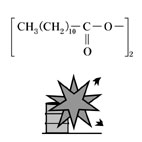| Case Name |
Explosion in a cleaning tank at a lauroyl peroxide manufacturing plant |
| Pictograph |

|
| Date |
September 11, 1967 |
| Place |
Kawagoe, Saitama, Japan |
| Location |
Chemical factory |
| Overview |
Toluene solution of LPO in the pressure drum for hot-water cleaning exploded at a LPO manufacturing plant. The cause of the explosion was considered to be contamination by impurities or contact with iron exposed at the broken glass lining on the inside surface of the tank, etc. |
| Incident |
At a lauroyl peroxide (LPO) manufacturing plant, a toluene solution of LPO in a pressure drum for hot-water washing exploded. The chemical reaction formula of LPO synthesis is shown in Fig3. |
| Processing |
Manufacture |
| Individual Process |
Separation |
| Process Flow |
Fig2.Unit process flow
|
| Chemical Reaction |
Oxidation |
| Chemical Equation |
Fig3.Chemical reaction formula (reference)
|
| Substance |
Lauloyl peroxide, Fig4 |
| Type of Accident |
Explosion |
| Sequence |
1. Lauroyl chloride was synthesized by the reaction of phosphorus trichloride and lauroyl acid. Then it was oxidized by a toluene solution of hydrogen peroxide and sodium hydroxide to generate LPO.
2. It was sent to a cleaning drum for warm-water washing to remove sodium lauroyl.
3. The cleaning drum exploded during transfer of the toluene layer including LPO to the filter after separation of the aqueous phase. |
| Cause |
It might have been the LPO that exploded. The cause of the explosion was considered as follows.
1. Contents of the cleaning drum became acidic and decomposition of LPO was promoted.
2. As the glass lining of the cleaning drum was damaged, iron inside the drum was exposed. The iron might act as a catalyst, and LPO was decomposed abnormally.
3. The temperature of the hot water for cleaning was high enough to decompose LPO.
4. Errors or changes were made when arranging the raw material.
5. There was contamination with foreign material. |
| Countermeasures |
The following are general measures to prevent the decomposition of peroxides.
1. Temperature control must be done thoroughly. An automatic system avoiding temperature rise is adopted.
2. The following are prepared: Sufficient facilities and operation instructions to avoid friction and/or impact.
3. Contact with metal and contamination by impurities are prevented. Preventing damage to coating.
In addition, clarification of countermeasures against an abnormal situation and prevention of miss-operation are necessary. |
| Knowledge Comment |
A preliminary evaluation of the unusual reaction with impurities is indispensable on handling potentially hazardous materials. |
| Background |
It is speculated that managers did not understand the hazardous decomposition of LPO, or could not make operators understand it. As the manufacturer should have known that peroxides decompose easily, it would be a problem that operation indication and facility management were not insufficient. |
| Reason for Adding to DB |
Example of hazards of organic peroxide |
| Scenario |
| Primary Scenario
|
Insufficient Analysis or Research, Insufficient Prior Research, Insufficient Study of Properties, Poor Value Perception, Poor Safety Awareness, Insuficient Education/Training for Safety, Usage, Operation/Use, Bad Condition during Operation, Bad Event, Chemical Phenomenon, Abnormal Reaction, Secondary Damage, External Damage, Explosion, Bodily Harm, Death, Bodily Harm, Injury, Loss to Organization, Economic Loss, Reactor Severe Damaged
|
|
| Sources |
Japan Assoc. of fire science and engineering Chemical fire committee, C.2.2, Organic peroxide. Case 199, Examples of chemical fires (2 ), p.63 (1974)
Masamitsu Tamura, Masahide Wakakura, Explosion and fire at a lauroyl peroxide manufacturing plant. Reaction danger. -Accident case and analysis- p.64(1995)
The Ministry of Labor. Industrial Safety and Health Department. Safety section, Fire caused by explosion in cleaning and filtration process of lauroyl acid peroxide manufacturing plant. Safety of batch process, pp.52-53(1987)
|
| Number of Deaths |
1 |
| Number of Injuries |
1 |
| Physical Damage |
The cleaning tank was seriously damaged. |
| Multimedia Files |
Fig4.Chemical formula
|
| Field |
Chemicals and Plants
|
| Author |
ARAI, Mitsuru (Environmental Science Center, The University of Tokyo)
TAMURA, Masamitsu (Center for Risk Management and Safety Sciences, Yokohama National University)
|
|